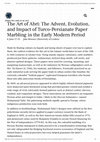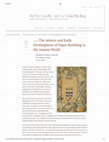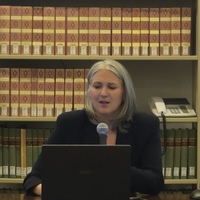Videos by Jake Benson
2018 marks the 50th anniversary of the death of Chester Beatty who was responsible for amassing w... more 2018 marks the 50th anniversary of the death of Chester Beatty who was responsible for amassing what has been called the finest private collection of manuscripts and books of the 20th century. As a result of his gift to the nation Beatty became the first person to receive honorary citizenship of Ireland and upon his death, the first private citizen in Irish history ever to receive a state funeral. This fascinating documentary offers us a unique insight into the man, his amazing collection and the work that goes into preserving it.
http://www.newdecade.ie/portfolio/chester-beatty/ 33 views
Conference Presentations by Jake Benson

MetSpeaks-Spring Fellows Colloquia, 2019
Made by floating colors on various liquids and carefully laying a sheet on top, marbled papers ha... more Made by floating colors on various liquids and carefully laying a sheet on top, marbled papers have captivated the eyes of many around the world for several centuries. The earliest evidence for this art in the Islamic world dates to turn-of-the-sixteenth-century Greater Iran, where it emerged from a context of multifarious decorated paper production for Persianate manuscripts. By 1600, a far more technically advanced method emerged, made with highly refined mineral pigments and other colorants dispersed on the surface of thickened sizing that yielded far more intricate and consistently formed patterns. Exemplified by the vivid attached margins of The Met’s Mantiq al-Tayr (63.210), these innovations are attributed to the enigmatic Persian artist Muhammad Tahir, an émigré to India, probably to the Deccan Sultanates. His patterning methods rapidly spread from the Indian Subcontinent all the way to Europe, where aside from book bindings, they were soon applied as the first polychrome security device to paper currency issued by the Bank of England in 1695, “Sola bills” for the Georgia Colony in 1740, as well as the first twenty-dollar bills printed in Philadelphia by the Second Continental Congress in 1775.
CODICOLOGÍA E HISTORIA DEL LIBRO MANUSCRITO EN CARACTERES ÁRABES, 2010

Certain Safavid manuscripts, such as a copy of Farīd al-DīnʿAṭṭār’s Manṭiq al-Ṭayr (MMA 63.210.35... more Certain Safavid manuscripts, such as a copy of Farīd al-DīnʿAṭṭār’s Manṭiq al-Ṭayr (MMA 63.210.35), and a double-page illustration of The Princely Hawking Party attributed to Mīrzā ʿAlī (MMA2.223.1 and MFA14.624), are embellished with marbled paper borders with quite different stylistic features. The evolution of these decorative papers resulted from exchanges between artists regarding their methods, materials, as well as their individual talents and tastes. Additionally, these papers not only document the evolution of the art of marbling, but also demonstrate the extent to which members of the Safavid ruling elite deliberately fostered this trend in Iran.
The marbled pattern surrounding The Princely Hawking Party dating to approximately 1570 CE is comparatively primitive, with pale and diffuse colors, and yet it also cleverly connects with the marginal painting of the inner border at specific intervals. A comparison of these inner and outer borders reveals that painted elements were consciously based on the contours of the surrounding marbled pattern. Streams of water merge with the marbling, proving that the latter was intentionally considered as an element of the entire composition when it was originally executed.
In contrast, gold-flecked marbled borders were added to the Manṭiq al-Ṭayr, when the manuscript was refurbished, which likely occurred in the library of the Shrine of Shāh Ṣāfī in Ardabil. These leaves feature a vivid array of colorful patterns that also provide a striking contrast to the rest of the manuscript. Two surviving letters addressed to Mīr Muḥammad Ṭāhir, a Persian marbling artist living in India, sheds light upon why this choice was made. The letters, written by the artists Mullā Khalīl Vaqqārī and Yahyà Qazvīnī (the latter a paper marbler mentioned by Qāżī Aḥmad Qummī in his Gulistān-i Hunar), relate their enthusiastic reaction to seeing Muḥammad Ṭāhir’s work. These artistic exchanges in Iran and India confirm how the art of marbling evolved.
http://www.metmuseum.org/metmedia/video/collections/isl/looking-widely-looking-closely-symposium-part-9
Publications by Jake Benson
In Iran and the Deccan: Persianate Art, Culture, and Talent in Circulation, 1400–1700. , 2020
What follows is a translation of the double-page vaqfnama (endowment deed) in the Qur’an manuscri... more What follows is a translation of the double-page vaqfnama (endowment deed) in the Qur’an manuscript copied by ‘Abd al-Qadir al-Husayni al-Shirazi and endowed by Ibrahim Qutb Shah (r. 1550–80) of Golconda to the Shrine of Imam Riza at Mashhad in 970/1562 (Astan-i Quds-i Razavi, no. 106). For a discussion of the codex and reproduction of the vaqfnama spread, see Habibi in this volume and figs. 7.2–7.3.

Iran and the Deccan: Persianate Art, Culture, and Talent in Circulation, 1400–1700., 2020
A nearly intact muraqqa‘ (album) dubbed Qit‘at-i Khushkhatt (Specimens
of Fine Penmanship; Univer... more A nearly intact muraqqa‘ (album) dubbed Qit‘at-i Khushkhatt (Specimens
of Fine Penmanship; University of Edinburgh Library, Or. Ms. 373)
preserves a pastiche of mounted pages detached from various Persian
and Arabic manuscripts, two European woodcuts (fols. 22v–23r), and
fragments of a Safavid official document with a tughra (calligraphic
insignia) bearing the names and titles of Shah Tahmasp I (r. 1524–76)
(fols. 30v–31r). Also featured are many signed calligraphic specimens
(sing. qita‘; pl. qit‘at) by famed fifteenth- and sixteenth-century Persian
masters, including Mir ‘Ali Haravi (d. 1544–45) (fol. 7v), Malik Daylami
(d. 1561–62) (fols. 23v, 24v), and Shah Mahmud Nishapuri (d. 1564–65)
(fols. 17v–18r; 30r), among others. A rare example dated 2 Ramadan
978/February 2, 1571, by Maqsud Tabrizi (fols. 24v–25r) provides a terminus post quem for the album’s assembly. In addition to these large
specimens of calligraphy, 327 smaller fragments in Persian, Arabic, and
Chagatai Turkish are adhered to the surrounding margins in a manner
consistent with late-sixteenth-century Persianate albums. Brilliantly
colored abri (marbled paper) margins adorn every page, but the vivid
patterns have elicited skepticism over whether they were part of the
album’s original construction or added later during restoration.
Aside from praising God, as well as the Prophet Muhammad (d. 632)
and his progeny, the album preface lauds only one other individual,
Muhammad Tahir, whose identity and production will be discussed
below. Inexplicably, it does not name any of the famed masters whose
works are featured within the album. Nor does it mention a compiler,
patron, or place of production. A holistic examination of the codicology,
condition, and content of the album—encompassing its preface, calligraphies, drawings, and abri margins—is necessary to both authenticate its construction and determine a context for its production.

American Journal of Numismatics, 31, 2019
Many numismatic historians and collectors are familiar with an emission of 10,800 twenty-dollar b... more Many numismatic historians and collectors are familiar with an emission of 10,800 twenty-dollar bills that the Continental Congress authorized on July 22–23, 1775, then issued with the back-date of May 10, when the Second Continental Congress convened in Philadelphia. They were printed on sheets bearing a curious, hand-marbled polychrome margin along the left side of the obverse as a security device. The marbled papers are thought to have been procured by Benjamin Franklin, who also designed the emblem on the obverse depicting the wind blowing over waves surmounted by a Latin motto VI CONCITATÆ (driven by force; Pl. 37, 1). Avid interest among numismatic collectors in this specific emission has resulted in five-figure sales at auction in recent years, a considerable sum for historical paper currency. Prior writers have attributed the concept of security marbling to Franklin’s genius; however, it will be shown that this practice was already well-established in London prior to, during, and well after the periods that he resided there.
Significant evidence proves that the formative years of fractional reserve banking and issuance of paper currency were intimately intertwined with the advent of paper marbling in England. Together with new research on the origins and evolution of marbling in the Islamic world, and its subsequent spread to Europe, this essay provides an overview of security marbling throughout the "long eighteenth century" (ca. 1695–1815), until it was ultimately superseded by mechanized security printing.
Shii Studies Review, 3, no. 1–2., 2019
Over the course of the last year the Hill Museum and Manuscript Library (HMML) and the Roshan Ins... more Over the course of the last year the Hill Museum and Manuscript Library (HMML) and the Roshan Institute for Persian Studies at the University of Maryland, College Park (Roshan Institute-UMD) have begun collaborating with the Raja of Mahmudabad family on the preservation of their important manuscript collection. The project will help protect the collection through both physical and digital preservation efforts and expand access to it through improved cataloging and digital display in HMML’s online manuscript reading room, vHMML. Funding for the various elements of this broader plan has generously been provided by the British Library’s Endangered Archives Programme (EAP), HMML, Roshan Institute-UMD, and the Islamic Manuscript Association.
Society of Marbling Annual, 2006
Society of Marbling Annual., 2005
Sultans of Deccan India, 1500–1700: Opulence and Fantasy., 2015

Persian Language, Literature, and Culture: New Leaves, Fresh Looks., 2015
Fluctuating changes in style are often described in terms of fashion when in fact they are often ... more Fluctuating changes in style are often described in terms of fashion when in fact they are often developed to better meet practical demands. This is especially true of bookbinding craft techniques in the Islamic world that evolved from scribal practices of the Late Antique period into a distinct trade over time. Instead of an individual scribe producing an entire manuscript from start to finish, a specialized bookbinder would focus strictly on producing the cover of a manuscript, often in a range of styles depending on their patron’s taste and budget.
By the 16th century, bookbinders in the Eastern Islamic world adopted a number of innovative procedures that reduced the cost and increase the speed at which books could be produced. Panel stamping largely supplanted the time-consuming process of tooling covers by hand. Cloth and decorative papers were adapted as frugal covering materials in place of more costly leather, and one particular method of minimal leather used only along with the spin, flap, and edges of the board are commonly observed today covering a wide variety of materials. While some of these advances allowed books to be luxuriously decorated for members of the elite, these methods were also used to produce affordable covers that catered to less affluent members of society. These methods proved so effective that with the passage of time, they supplanted earlier methods and became established traditions in their own right.
In the 19th century, the arrival of mechanized printing and lithography directly impacted the bookbinding trade. In the specific context of Iran, several important documents shed light on governmental reforms that were implemented in the 1860s in response to the burgeoning printing industry. These reforms were initiated by ‘Itiżād al-Ṣaltana, a half brother of Nāsir al-Dīn Shāh Qajār, who served as the first Vazīr-i ‘Ulūm, or the Minister of Sciences of Iran. Fortunately, a set of legal resolutions approved by the Shah survives today that explains the changes, and a summary announcement in the newspaper Rūznāma-yi Dawlat-i Ālī-yi Īrān confirms that these reforms were in fact carried out.
Modernization came about through contact with Europe but was also facilitated by print media resulting in the free exchange of information and ideas within the Islamic world. One Indo-Persian treatise, the Kashf al-Ṣinā'at va Makhzan al-Beżā'at, or ‘Muntakhab-i Muḥammadī’, compiles both traditional and foreign techniques for making inks, dyes, and paper coatings, as well as novel adaptations of traditional methods, such as marbling the edges of a text block in the European manner. When considered together with surviving physical evidence, these documents help to explain why, how, and to what extent the bookbinding trade dramatically changed in the Early Modern period.
NOTE: While I employed the term "leather-edge binding" in this published essay, I now prefer the "hemmed binding" as it is both an accurate translation of the various Persian terms mentioned and also sufficiently describes the appearance.
In The Empires of the Near East and India: Source Studies of the Safavid, Ottoman, and Mughal Literate Communities. Ed. Hani Khafipour. New York: Columbia University Press, pp. 554-96. , 2019
https://cup.columbia.edu/book/the-empires-of-the-near-east-and-india/9780231174374
Talks by Jake Benson

Khalili Research Centre, Oxford University, 2019
Made by floating colours on liquids and laying sheets of paper over top to capture them, the earl... more Made by floating colours on liquids and laying sheets of paper over top to capture them, the earliest evidence for this art in the Islamic world dates to turn of the 15th to 16th centuries in Greater Iran. Using mainly organic colourants, early marblers produced just three patterns: rudimentary stylized drop-motifs, soft swirls, and abstract spotted designs. These papers were used for covering, mounting, and margining manuscripts, as well as for stationery by Persian calligraphers such as Mir ‘Ali Haravi (d. 1544), his students, and followers. Eventually practised on an early-industrial scale serving the paper trade in urban centres like Istanbul, the curiously colourful “Turkish papers” captivated European travellers who bound them into alba amicorum (books of friendship).
By 1600, an advanced process appeared in which highly refined mineral pigments were dispersed upon thickened sizing that provided greater control and yielded a wide range of vivid, intricately-formed patterns such as distinct curled, chevron, combed, and craquelure designs. These innovations are attributed to an enigmatic Persian artist and émigré to India— likely to the Deccan Sultanates— named Muhammad Tahir. His patterning methods rapidly spread to Europe, where indigenous production soon took hold.
In addition to bookbindings, Muhammad Tahir’s designs were utilised as the first polychrome security device applied to paper currency issued by the Bank of England in 1695, as well as the first American twenty-dollar bills issued in 1775, and promissory notes used by Benjamin Franklin to secure French financing for the War of Independence (1779–82). In this way, the colourful marbling of a Persian Muslim immigrant to India proved to be a transformative technology that not only safeguarded the fledging fractional reserve economies of England and the United States at critical junctures but even helped guarantee the latter’s independence.

Netherlands Institute in Turkey, 2017
Known as ebru in Modern Turkish today, marbled papers were called kāġaẕ-i abrī (“clouded paper” i... more Known as ebru in Modern Turkish today, marbled papers were called kāġaẕ-i abrī (“clouded paper” in Persian)- or more simply as abrī -in more than seventy Persian, Ottoman, Chaghatai, and Urdu sources. The advent and early history of this art in the Islamic world are enigmatic. While some claim it is very old, the earliest evidence only dates to the end of the fifteenth-century, suggesting it emerged from a context of prodigious and multifarious decorated paper production during the Timurid era.
The earliest technical account from India, dated before AH 1014/1605 CE, describes marbling on a water bath with organic colourants, resulting in a limited range of pale, softly swirled, or turbulent patterns. A second method describes dispersing mineral pigments on a mucilaginous bath extracted from fenugreek seeds. If spattered, the droplets would randomly fall and form pebble-like designs, but if applied in individual drops and bisected with a bristle or stylus, simple leaf-like motifs designs could be formed.
Such simple drop-motifs are found on our earliest dated evidence, a pair of marbled leaves, one bearing a note stating that they were a gift “from Iran” to Sultan Ghiyath al-Din Khalji of Mandu in AH 901/1496 CE. This is contemporaneous with an attribution for the invention of abrī to the Timurid munshi Abdullah Murvarid of Herat (d. AH 921/1515 CE). Other bisected drop-motifs arranged rows arranged in alternating colours and rows are found on a practice sheet signed by Jamal al-Shirazi in AH 920/1514 CE. Both examples prove such simple drop-motifs are among the earliest abrī designs, some 250 years before Hatip Mehmed Ef. (d. AH 1187/1773 CE).
The similarity of primitive styles manufactured a large geographic region makes it challenging to ascertain provenance for many early abrī papers. Mir ‘Ali Haravi (d. AH 951/1544–45 CE) frequently composed poems and riddles upon softly swirled patterns, a practice imitated his students and followers. Similar papers found in découpage manuscripts in Topkapı Palace dated AH 946/1539–40 CE, but we cannot say where the papers were made. In contrast, a copy of Sharḥ al-Wasīṭ completed in Kütahya in the AH mid-Jumada al-Ūlā 966/late-February 1559 CE, may indicate the earliest indigenous Anatolian manufacture. Early European friendship books that incorporate Ottoman papers prove the art was soon practised on a modest industrial scale by stationers in Istanbul. Many of the designs are extremely similar to early pebbled patterns used by Shah Mahmud Nishapuri (d. 1566–67) in Mashhad, and even a Bijapuri miscellany written in 1572–80, making it difficult to distinguish local from regional trends.
In circa 1600, patterns become more sophisticated, a style called haft rang abrī (seven-colour abrī), attributed to an enigmatic figure named Mir Muhammad Tahir, a member of the Safavid elite who emigrated to the Deccan in India, where he attained mastery over the art. Muhammad Tahir’s methods spread rapidly throughout the eastern Islamic world, and evidence suggests that Ottoman artists readily adopted his pattern-making procedures. Yet the earliest, anonymously written Ottoman Turkish technical account, Tertîb-i Risâle-yi Ebrî (Composition of a Treatise on Marbling), an artists' miscellany compiled from earlier sources sometime after 1615 recounts how Indian materials like soapberry were unavailable, implying that readily available local materials such as ox gall were substituted instead. In doing so, early Ottoman marblers developed their own unique methods and approaches with their own distinct tradition of marbling that ultimately flowered into the contemporary practice of ebru.
Papers by Jake Benson
Indiana University Press eBooks, Jun 2, 2020

Netherlands Institute in Turkey, 2017
Known as ebru in Modern Turkish today, marbled papers were called kāġaẕ-i abrī (“clouded paper” i... more Known as ebru in Modern Turkish today, marbled papers were called kāġaẕ-i abrī (“clouded paper” in Persian)- or more simply as abrī -in more than seventy Persian, Ottoman, Chaghatai, and Urdu sources. The advent and early history of this art in the Islamic world are enigmatic. While some claim it is very old, the earliest evidence only dates to the end of the fifteenth-century, suggesting it emerged from a context of prodigious and multifarious decorated paper production during the Timurid era. The earliest technical account from India, dated before AH 1014/1605 CE, describes marbling on a water bath with organic colourants, resulting in a limited range of pale, softly swirled, or turbulent patterns. A second method describes dispersing mineral pigments on a mucilaginous bath extracted from fenugreek seeds. If spattered, the droplets would randomly fall and form pebble-like designs, but if applied in individual drops and bisected with a bristle or stylus, simple leaf-like motifs designs could be formed. Such simple drop-motifs are found on our earliest dated evidence, a pair of marbled leaves, one bearing a note stating that they were a gift “from Iran” to Sultan Ghiyath al-Din Khalji of Mandu in AH 901/1496 CE. This is contemporaneous with an attribution for the invention of abrī to the Timurid munshi Abdullah Murvarid of Herat (d. AH 921/1515 CE). Other bisected drop-motifs arranged rows arranged in alternating colours and rows are found on a practice sheet signed by Jamal al-Shirazi in AH 920/1514 CE. Both examples prove such simple drop-motifs are among the earliest abrī designs, some 250 years before Hatip Mehmed Ef. (d. AH 1187/1773 CE). The similarity of primitive styles manufactured a large geographic region makes it challenging to ascertain provenance for many early abrī papers. Mir ‘Ali Haravi (d. AH 951/1544–45 CE) frequently composed poems and riddles upon softly swirled patterns, a practice imitated his students and followers. Similar papers found in découpage manuscripts in Topkapı Palace dated AH 946/1539–40 CE, but we cannot say where the papers were made. In contrast, a copy of Sharḥ al-Wasīṭ completed in Kütahya in the AH mid-Jumada al-Ūlā 966/late-February 1559 CE, may indicate the earliest indigenous Anatolian manufacture. Early European friendship books that incorporate Ottoman papers prove the art was soon practised on a modest industrial scale by stationers in Istanbul. Many of the designs are extremely similar to early pebbled patterns used by Shah Mahmud Nishapuri (d. 1566–67) in Mashhad, and even a Bijapuri miscellany written in 1572–80, making it difficult to distinguish local from regional trends. In circa 1600, patterns become more sophisticated, a style called haft rang abrī (seven-colour abrī), attributed to an enigmatic figure named Mir Muhammad Tahir, a member of the Safavid elite who emigrated to the Deccan in India, where he attained mastery over the art. Muhammad Tahir’s methods spread rapidly throughout the eastern Islamic world, and evidence suggests that Ottoman artists readily adopted his pattern-making procedures. Yet the earliest, anonymously written Ottoman Turkish technical account, Tertîb-i Risâle-yi Ebrî (Composition of a Treatise on Marbling), an artists' miscellany compiled from earlier sources sometime after 1615 recounts how Indian materials like soapberry were unavailable, implying that readily available local materials such as ox gall were substituted instead. In doing so, early Ottoman marblers developed their own unique methods and approaches with their own distinct tradition of marbling that ultimately flowered into the contemporary practice of ebru.











Uploads
Videos by Jake Benson
http://www.newdecade.ie/portfolio/chester-beatty/
Conference Presentations by Jake Benson
The marbled pattern surrounding The Princely Hawking Party dating to approximately 1570 CE is comparatively primitive, with pale and diffuse colors, and yet it also cleverly connects with the marginal painting of the inner border at specific intervals. A comparison of these inner and outer borders reveals that painted elements were consciously based on the contours of the surrounding marbled pattern. Streams of water merge with the marbling, proving that the latter was intentionally considered as an element of the entire composition when it was originally executed.
In contrast, gold-flecked marbled borders were added to the Manṭiq al-Ṭayr, when the manuscript was refurbished, which likely occurred in the library of the Shrine of Shāh Ṣāfī in Ardabil. These leaves feature a vivid array of colorful patterns that also provide a striking contrast to the rest of the manuscript. Two surviving letters addressed to Mīr Muḥammad Ṭāhir, a Persian marbling artist living in India, sheds light upon why this choice was made. The letters, written by the artists Mullā Khalīl Vaqqārī and Yahyà Qazvīnī (the latter a paper marbler mentioned by Qāżī Aḥmad Qummī in his Gulistān-i Hunar), relate their enthusiastic reaction to seeing Muḥammad Ṭāhir’s work. These artistic exchanges in Iran and India confirm how the art of marbling evolved.
http://www.metmuseum.org/metmedia/video/collections/isl/looking-widely-looking-closely-symposium-part-9
Publications by Jake Benson
of Fine Penmanship; University of Edinburgh Library, Or. Ms. 373)
preserves a pastiche of mounted pages detached from various Persian
and Arabic manuscripts, two European woodcuts (fols. 22v–23r), and
fragments of a Safavid official document with a tughra (calligraphic
insignia) bearing the names and titles of Shah Tahmasp I (r. 1524–76)
(fols. 30v–31r). Also featured are many signed calligraphic specimens
(sing. qita‘; pl. qit‘at) by famed fifteenth- and sixteenth-century Persian
masters, including Mir ‘Ali Haravi (d. 1544–45) (fol. 7v), Malik Daylami
(d. 1561–62) (fols. 23v, 24v), and Shah Mahmud Nishapuri (d. 1564–65)
(fols. 17v–18r; 30r), among others. A rare example dated 2 Ramadan
978/February 2, 1571, by Maqsud Tabrizi (fols. 24v–25r) provides a terminus post quem for the album’s assembly. In addition to these large
specimens of calligraphy, 327 smaller fragments in Persian, Arabic, and
Chagatai Turkish are adhered to the surrounding margins in a manner
consistent with late-sixteenth-century Persianate albums. Brilliantly
colored abri (marbled paper) margins adorn every page, but the vivid
patterns have elicited skepticism over whether they were part of the
album’s original construction or added later during restoration.
Aside from praising God, as well as the Prophet Muhammad (d. 632)
and his progeny, the album preface lauds only one other individual,
Muhammad Tahir, whose identity and production will be discussed
below. Inexplicably, it does not name any of the famed masters whose
works are featured within the album. Nor does it mention a compiler,
patron, or place of production. A holistic examination of the codicology,
condition, and content of the album—encompassing its preface, calligraphies, drawings, and abri margins—is necessary to both authenticate its construction and determine a context for its production.
Significant evidence proves that the formative years of fractional reserve banking and issuance of paper currency were intimately intertwined with the advent of paper marbling in England. Together with new research on the origins and evolution of marbling in the Islamic world, and its subsequent spread to Europe, this essay provides an overview of security marbling throughout the "long eighteenth century" (ca. 1695–1815), until it was ultimately superseded by mechanized security printing.
By the 16th century, bookbinders in the Eastern Islamic world adopted a number of innovative procedures that reduced the cost and increase the speed at which books could be produced. Panel stamping largely supplanted the time-consuming process of tooling covers by hand. Cloth and decorative papers were adapted as frugal covering materials in place of more costly leather, and one particular method of minimal leather used only along with the spin, flap, and edges of the board are commonly observed today covering a wide variety of materials. While some of these advances allowed books to be luxuriously decorated for members of the elite, these methods were also used to produce affordable covers that catered to less affluent members of society. These methods proved so effective that with the passage of time, they supplanted earlier methods and became established traditions in their own right.
In the 19th century, the arrival of mechanized printing and lithography directly impacted the bookbinding trade. In the specific context of Iran, several important documents shed light on governmental reforms that were implemented in the 1860s in response to the burgeoning printing industry. These reforms were initiated by ‘Itiżād al-Ṣaltana, a half brother of Nāsir al-Dīn Shāh Qajār, who served as the first Vazīr-i ‘Ulūm, or the Minister of Sciences of Iran. Fortunately, a set of legal resolutions approved by the Shah survives today that explains the changes, and a summary announcement in the newspaper Rūznāma-yi Dawlat-i Ālī-yi Īrān confirms that these reforms were in fact carried out.
Modernization came about through contact with Europe but was also facilitated by print media resulting in the free exchange of information and ideas within the Islamic world. One Indo-Persian treatise, the Kashf al-Ṣinā'at va Makhzan al-Beżā'at, or ‘Muntakhab-i Muḥammadī’, compiles both traditional and foreign techniques for making inks, dyes, and paper coatings, as well as novel adaptations of traditional methods, such as marbling the edges of a text block in the European manner. When considered together with surviving physical evidence, these documents help to explain why, how, and to what extent the bookbinding trade dramatically changed in the Early Modern period.
NOTE: While I employed the term "leather-edge binding" in this published essay, I now prefer the "hemmed binding" as it is both an accurate translation of the various Persian terms mentioned and also sufficiently describes the appearance.
Talks by Jake Benson
By 1600, an advanced process appeared in which highly refined mineral pigments were dispersed upon thickened sizing that provided greater control and yielded a wide range of vivid, intricately-formed patterns such as distinct curled, chevron, combed, and craquelure designs. These innovations are attributed to an enigmatic Persian artist and émigré to India— likely to the Deccan Sultanates— named Muhammad Tahir. His patterning methods rapidly spread to Europe, where indigenous production soon took hold.
In addition to bookbindings, Muhammad Tahir’s designs were utilised as the first polychrome security device applied to paper currency issued by the Bank of England in 1695, as well as the first American twenty-dollar bills issued in 1775, and promissory notes used by Benjamin Franklin to secure French financing for the War of Independence (1779–82). In this way, the colourful marbling of a Persian Muslim immigrant to India proved to be a transformative technology that not only safeguarded the fledging fractional reserve economies of England and the United States at critical junctures but even helped guarantee the latter’s independence.
The earliest technical account from India, dated before AH 1014/1605 CE, describes marbling on a water bath with organic colourants, resulting in a limited range of pale, softly swirled, or turbulent patterns. A second method describes dispersing mineral pigments on a mucilaginous bath extracted from fenugreek seeds. If spattered, the droplets would randomly fall and form pebble-like designs, but if applied in individual drops and bisected with a bristle or stylus, simple leaf-like motifs designs could be formed.
Such simple drop-motifs are found on our earliest dated evidence, a pair of marbled leaves, one bearing a note stating that they were a gift “from Iran” to Sultan Ghiyath al-Din Khalji of Mandu in AH 901/1496 CE. This is contemporaneous with an attribution for the invention of abrī to the Timurid munshi Abdullah Murvarid of Herat (d. AH 921/1515 CE). Other bisected drop-motifs arranged rows arranged in alternating colours and rows are found on a practice sheet signed by Jamal al-Shirazi in AH 920/1514 CE. Both examples prove such simple drop-motifs are among the earliest abrī designs, some 250 years before Hatip Mehmed Ef. (d. AH 1187/1773 CE).
The similarity of primitive styles manufactured a large geographic region makes it challenging to ascertain provenance for many early abrī papers. Mir ‘Ali Haravi (d. AH 951/1544–45 CE) frequently composed poems and riddles upon softly swirled patterns, a practice imitated his students and followers. Similar papers found in découpage manuscripts in Topkapı Palace dated AH 946/1539–40 CE, but we cannot say where the papers were made. In contrast, a copy of Sharḥ al-Wasīṭ completed in Kütahya in the AH mid-Jumada al-Ūlā 966/late-February 1559 CE, may indicate the earliest indigenous Anatolian manufacture. Early European friendship books that incorporate Ottoman papers prove the art was soon practised on a modest industrial scale by stationers in Istanbul. Many of the designs are extremely similar to early pebbled patterns used by Shah Mahmud Nishapuri (d. 1566–67) in Mashhad, and even a Bijapuri miscellany written in 1572–80, making it difficult to distinguish local from regional trends.
In circa 1600, patterns become more sophisticated, a style called haft rang abrī (seven-colour abrī), attributed to an enigmatic figure named Mir Muhammad Tahir, a member of the Safavid elite who emigrated to the Deccan in India, where he attained mastery over the art. Muhammad Tahir’s methods spread rapidly throughout the eastern Islamic world, and evidence suggests that Ottoman artists readily adopted his pattern-making procedures. Yet the earliest, anonymously written Ottoman Turkish technical account, Tertîb-i Risâle-yi Ebrî (Composition of a Treatise on Marbling), an artists' miscellany compiled from earlier sources sometime after 1615 recounts how Indian materials like soapberry were unavailable, implying that readily available local materials such as ox gall were substituted instead. In doing so, early Ottoman marblers developed their own unique methods and approaches with their own distinct tradition of marbling that ultimately flowered into the contemporary practice of ebru.
Papers by Jake Benson
http://www.newdecade.ie/portfolio/chester-beatty/
The marbled pattern surrounding The Princely Hawking Party dating to approximately 1570 CE is comparatively primitive, with pale and diffuse colors, and yet it also cleverly connects with the marginal painting of the inner border at specific intervals. A comparison of these inner and outer borders reveals that painted elements were consciously based on the contours of the surrounding marbled pattern. Streams of water merge with the marbling, proving that the latter was intentionally considered as an element of the entire composition when it was originally executed.
In contrast, gold-flecked marbled borders were added to the Manṭiq al-Ṭayr, when the manuscript was refurbished, which likely occurred in the library of the Shrine of Shāh Ṣāfī in Ardabil. These leaves feature a vivid array of colorful patterns that also provide a striking contrast to the rest of the manuscript. Two surviving letters addressed to Mīr Muḥammad Ṭāhir, a Persian marbling artist living in India, sheds light upon why this choice was made. The letters, written by the artists Mullā Khalīl Vaqqārī and Yahyà Qazvīnī (the latter a paper marbler mentioned by Qāżī Aḥmad Qummī in his Gulistān-i Hunar), relate their enthusiastic reaction to seeing Muḥammad Ṭāhir’s work. These artistic exchanges in Iran and India confirm how the art of marbling evolved.
http://www.metmuseum.org/metmedia/video/collections/isl/looking-widely-looking-closely-symposium-part-9
of Fine Penmanship; University of Edinburgh Library, Or. Ms. 373)
preserves a pastiche of mounted pages detached from various Persian
and Arabic manuscripts, two European woodcuts (fols. 22v–23r), and
fragments of a Safavid official document with a tughra (calligraphic
insignia) bearing the names and titles of Shah Tahmasp I (r. 1524–76)
(fols. 30v–31r). Also featured are many signed calligraphic specimens
(sing. qita‘; pl. qit‘at) by famed fifteenth- and sixteenth-century Persian
masters, including Mir ‘Ali Haravi (d. 1544–45) (fol. 7v), Malik Daylami
(d. 1561–62) (fols. 23v, 24v), and Shah Mahmud Nishapuri (d. 1564–65)
(fols. 17v–18r; 30r), among others. A rare example dated 2 Ramadan
978/February 2, 1571, by Maqsud Tabrizi (fols. 24v–25r) provides a terminus post quem for the album’s assembly. In addition to these large
specimens of calligraphy, 327 smaller fragments in Persian, Arabic, and
Chagatai Turkish are adhered to the surrounding margins in a manner
consistent with late-sixteenth-century Persianate albums. Brilliantly
colored abri (marbled paper) margins adorn every page, but the vivid
patterns have elicited skepticism over whether they were part of the
album’s original construction or added later during restoration.
Aside from praising God, as well as the Prophet Muhammad (d. 632)
and his progeny, the album preface lauds only one other individual,
Muhammad Tahir, whose identity and production will be discussed
below. Inexplicably, it does not name any of the famed masters whose
works are featured within the album. Nor does it mention a compiler,
patron, or place of production. A holistic examination of the codicology,
condition, and content of the album—encompassing its preface, calligraphies, drawings, and abri margins—is necessary to both authenticate its construction and determine a context for its production.
Significant evidence proves that the formative years of fractional reserve banking and issuance of paper currency were intimately intertwined with the advent of paper marbling in England. Together with new research on the origins and evolution of marbling in the Islamic world, and its subsequent spread to Europe, this essay provides an overview of security marbling throughout the "long eighteenth century" (ca. 1695–1815), until it was ultimately superseded by mechanized security printing.
By the 16th century, bookbinders in the Eastern Islamic world adopted a number of innovative procedures that reduced the cost and increase the speed at which books could be produced. Panel stamping largely supplanted the time-consuming process of tooling covers by hand. Cloth and decorative papers were adapted as frugal covering materials in place of more costly leather, and one particular method of minimal leather used only along with the spin, flap, and edges of the board are commonly observed today covering a wide variety of materials. While some of these advances allowed books to be luxuriously decorated for members of the elite, these methods were also used to produce affordable covers that catered to less affluent members of society. These methods proved so effective that with the passage of time, they supplanted earlier methods and became established traditions in their own right.
In the 19th century, the arrival of mechanized printing and lithography directly impacted the bookbinding trade. In the specific context of Iran, several important documents shed light on governmental reforms that were implemented in the 1860s in response to the burgeoning printing industry. These reforms were initiated by ‘Itiżād al-Ṣaltana, a half brother of Nāsir al-Dīn Shāh Qajār, who served as the first Vazīr-i ‘Ulūm, or the Minister of Sciences of Iran. Fortunately, a set of legal resolutions approved by the Shah survives today that explains the changes, and a summary announcement in the newspaper Rūznāma-yi Dawlat-i Ālī-yi Īrān confirms that these reforms were in fact carried out.
Modernization came about through contact with Europe but was also facilitated by print media resulting in the free exchange of information and ideas within the Islamic world. One Indo-Persian treatise, the Kashf al-Ṣinā'at va Makhzan al-Beżā'at, or ‘Muntakhab-i Muḥammadī’, compiles both traditional and foreign techniques for making inks, dyes, and paper coatings, as well as novel adaptations of traditional methods, such as marbling the edges of a text block in the European manner. When considered together with surviving physical evidence, these documents help to explain why, how, and to what extent the bookbinding trade dramatically changed in the Early Modern period.
NOTE: While I employed the term "leather-edge binding" in this published essay, I now prefer the "hemmed binding" as it is both an accurate translation of the various Persian terms mentioned and also sufficiently describes the appearance.
By 1600, an advanced process appeared in which highly refined mineral pigments were dispersed upon thickened sizing that provided greater control and yielded a wide range of vivid, intricately-formed patterns such as distinct curled, chevron, combed, and craquelure designs. These innovations are attributed to an enigmatic Persian artist and émigré to India— likely to the Deccan Sultanates— named Muhammad Tahir. His patterning methods rapidly spread to Europe, where indigenous production soon took hold.
In addition to bookbindings, Muhammad Tahir’s designs were utilised as the first polychrome security device applied to paper currency issued by the Bank of England in 1695, as well as the first American twenty-dollar bills issued in 1775, and promissory notes used by Benjamin Franklin to secure French financing for the War of Independence (1779–82). In this way, the colourful marbling of a Persian Muslim immigrant to India proved to be a transformative technology that not only safeguarded the fledging fractional reserve economies of England and the United States at critical junctures but even helped guarantee the latter’s independence.
The earliest technical account from India, dated before AH 1014/1605 CE, describes marbling on a water bath with organic colourants, resulting in a limited range of pale, softly swirled, or turbulent patterns. A second method describes dispersing mineral pigments on a mucilaginous bath extracted from fenugreek seeds. If spattered, the droplets would randomly fall and form pebble-like designs, but if applied in individual drops and bisected with a bristle or stylus, simple leaf-like motifs designs could be formed.
Such simple drop-motifs are found on our earliest dated evidence, a pair of marbled leaves, one bearing a note stating that they were a gift “from Iran” to Sultan Ghiyath al-Din Khalji of Mandu in AH 901/1496 CE. This is contemporaneous with an attribution for the invention of abrī to the Timurid munshi Abdullah Murvarid of Herat (d. AH 921/1515 CE). Other bisected drop-motifs arranged rows arranged in alternating colours and rows are found on a practice sheet signed by Jamal al-Shirazi in AH 920/1514 CE. Both examples prove such simple drop-motifs are among the earliest abrī designs, some 250 years before Hatip Mehmed Ef. (d. AH 1187/1773 CE).
The similarity of primitive styles manufactured a large geographic region makes it challenging to ascertain provenance for many early abrī papers. Mir ‘Ali Haravi (d. AH 951/1544–45 CE) frequently composed poems and riddles upon softly swirled patterns, a practice imitated his students and followers. Similar papers found in découpage manuscripts in Topkapı Palace dated AH 946/1539–40 CE, but we cannot say where the papers were made. In contrast, a copy of Sharḥ al-Wasīṭ completed in Kütahya in the AH mid-Jumada al-Ūlā 966/late-February 1559 CE, may indicate the earliest indigenous Anatolian manufacture. Early European friendship books that incorporate Ottoman papers prove the art was soon practised on a modest industrial scale by stationers in Istanbul. Many of the designs are extremely similar to early pebbled patterns used by Shah Mahmud Nishapuri (d. 1566–67) in Mashhad, and even a Bijapuri miscellany written in 1572–80, making it difficult to distinguish local from regional trends.
In circa 1600, patterns become more sophisticated, a style called haft rang abrī (seven-colour abrī), attributed to an enigmatic figure named Mir Muhammad Tahir, a member of the Safavid elite who emigrated to the Deccan in India, where he attained mastery over the art. Muhammad Tahir’s methods spread rapidly throughout the eastern Islamic world, and evidence suggests that Ottoman artists readily adopted his pattern-making procedures. Yet the earliest, anonymously written Ottoman Turkish technical account, Tertîb-i Risâle-yi Ebrî (Composition of a Treatise on Marbling), an artists' miscellany compiled from earlier sources sometime after 1615 recounts how Indian materials like soapberry were unavailable, implying that readily available local materials such as ox gall were substituted instead. In doing so, early Ottoman marblers developed their own unique methods and approaches with their own distinct tradition of marbling that ultimately flowered into the contemporary practice of ebru.